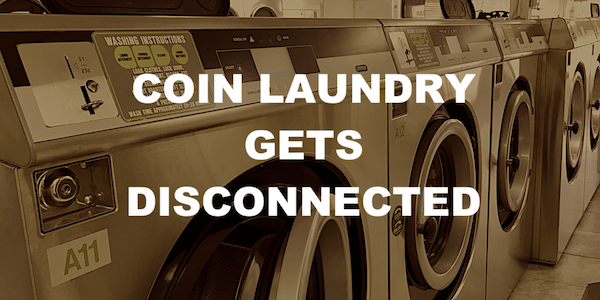Coin Laundry Gets Disconnected
It’s official. Coin laundry is out at the Coin Laundry Association.
CLA now stands for Connect, Learn, Advocate.
The announcement cites “industry shifts — from the dramatic rise in cashless payments to the demand for value-add services like wash and fold.”
Astonishingly, the acronym reflects none of that.
The really big news is coin getting ditched. But wait, polls show nine-in-ten store owners run quarters and 75% report the lion’s share of their machine transactions are by coin.
CLA sought to clarify the move in a follow-up email stating: “The primary reason for this is to better align our mission with the advancement of the industry and our dedication to innovation.”
Coin just isn’t cutting edge enough. Or so they say.
It’s all about who buys space
Coin laundry is universally recognized and requires no introduction.
Technically speaking, the North American Industry Classification System (NAICS), a standard used by the Census Bureau and others for data analysis, categorizes self-service laundry under Code 8123102, which leads with the term “Coin-operated laundries.”
Coin’s popularity is well known at CLA. Each year the association dutifully reports findings showing it’s the one pay format offered by more store owners than any other.
You would expect coin to garner attention from a national group named after it. But that isn’t the case. Coin powers laundry, not the association.
CLA doubles as a media organization, banking heavily on the supply chain promoting its wares to fund operations. In 2022, print and online advertising brought in substantially more revenue than member dues.
And as you probably guessed, the US Mint and Federal Reserve, which produce and distribute billions of coins to fuel laundromat transactions, don’t buy ad space in CLA’s Planet Laundry.
Wearing the coin label
Coin has historically defined self-serve laundry’s identity and trade organizations. Before a national association was formed in 1960 there were 25 existing grassroots groups — 19 with coin-op in their title.
That didn’t stop cashless pay. Maytag’s first-of-its-kind electronic ticket-operated machines debuted in 1962.
The coin laundry label stuck even as the industry evolved. It was short, memorable and to the point.
Coin, cashless and Cohen
The National Automatic Laundry and Cleaning Council (NALCC) rebranded as the Coin Laundry Association in 1983. Planet Laundry noted the change was initiated to “more accurately represent the organization’s mission and the industry it serves.”
Quarter-only pay was firmly taking hold back then, the very same year I embraced going cashless.
Coin had been good to the Cohen family’s laundry business — too good, in fact. Seeing my dad break his back toting home 12,000 quarters every week motivated me to spearhead conversion of our flagship to all tokens. Instantly, collections became lightweight and lightning fast as he pulled bills and headed out the door.
From that point forward my passion for innovative self-service pay grew.
Today I’m best known as a proponent of laundromat coinage. But what I really advocate for are the coin laundry owners themselves — our industry’s all but forgotten silent majority. Entrepreneurs who quietly cater to the public with a simple and dependable way to start machines.
I follow thousands of coin-ops on Facebook and proudly feature them alongside card, mobile and hybrid stores on my 3,900-member Laundromat Owners Showcase.
Mom-and-pop coin-ops
The laundromat industry appears to be as strong as ever. Yet for some reason CLA’s operator membership roll is declining and possibly headed to a level not seen in over half a century.
It begs the question: Is the association out of touch with most store owners?
The group prides itself on assembling a who’s who of top-tier multi-store operator members. Then there are the distributors with their own impressive chains. Plenty of deep pockets, large footprints and big iron — much of it vended coinless.
But what about the so-called mom-and-pops whose single outlet doesn’t fit the mold?
The national association reportedly had 1,260 owner-level members way back in 1970.
By 2007 the count was around 2,200 and dropped below 1,800 five years later.
A press release last month has the current figure standing at 1,500.
“We usually say it’s about 5,000 stores total that are in our network” was how CLA president Brian Wallace characterized his group’s collective ownership during a podcast three years ago.
Using the decade-old 29,000-store “census” count it still cites today, that works out to 17% — or one-in-six — of the nation’s laundromats operated by association members in 2021, leaving 83% unaffiliated.
Despite low representation among owners, CLA wields enormous influence over the industry and shapes much of the narrative.
The pay playbook
Lost in all of this are those running the average 30 washer/30 dryer quarter coin-op who struggle to cope with overflowing money boxes brought on by higher wash prices and lower dry minutes.
If the CLA truly wanted to advance the industry it would’ve gone straight to the playbook and educate the majority on the best practices of circulating higher denomination coins.
Golden dollars represent the next level for a business model that rose from nickels and dimes to quarters. The stair-step to dollar/quarter acceptance is seamless thanks to field-proven dual coin technology.
Unlike mobile pay’s meager adoption rates and limited impact on coin reduction, swapping out four quarters for a buck lowers handling by up to 80%.
Innovation in the coin sector also opened a gateway for cashless dollar tokens to be changer-dispensed using cash or credit and processed alongside dollars and quarters through a single inlet at laundry machines.
Dollar coinage’s compatibility with every pay format offers greater hybrid flexibility and an enhanced customer experience compared to quarter-only.
In short, dollars mean fewer coins.
I don’t ever recall the association mentioning how owners can retrofit an eight-buck washer to start with 8 coins instead of 32.
Or a surefire way for them to deliver their patrons more dry minutes per coin.
Or, for that matter, any talk of pivoting to tokens when changer draining or coin supply issues arise.
What I do recall however is watching CLA’s president tell an audience at one of the last Florida chapter meetings that coin pay was indeed on its way out and then me taking the podium to set the record straight quoting his own published data.
What I did see was the association’s 2021 online “Virtual Showcase” describing pay systems as “Mobile, card payments to old-fashioned quarters” before I fired off an email calling them out for the negative characterization of coin pay.
And what I’ve read over the past 24 months were three profiles of dollar/quarter stores in Planet Laundry where the pay format info went missing while similar stories on loyalty card stores laid out all the details.
CLA has done a masterful job developing an ecosystem to grow alternative pay platforms. I wish the same could be said for coin.
Out of sight, out of mind
The question was never if, but when the association would distance itself from the coin-operated sector.
Coin has long been in the group’s rear view mirror. And with the C-word now out of sight they’re betting it’ll soon be out of mind.
CLA changed “Coin” to “Connect.” Sadly, it’s another reminder of how disconnected the organization is from how the majority of laundromat owners operate.

Laurance Cohen is part of the Imonex team and welcomes inquiries on innovative payment solutions for your business.
laurance@imonex.com
(954) 999-7785


